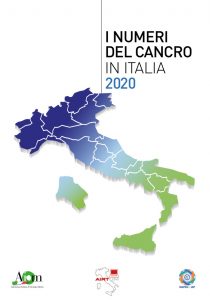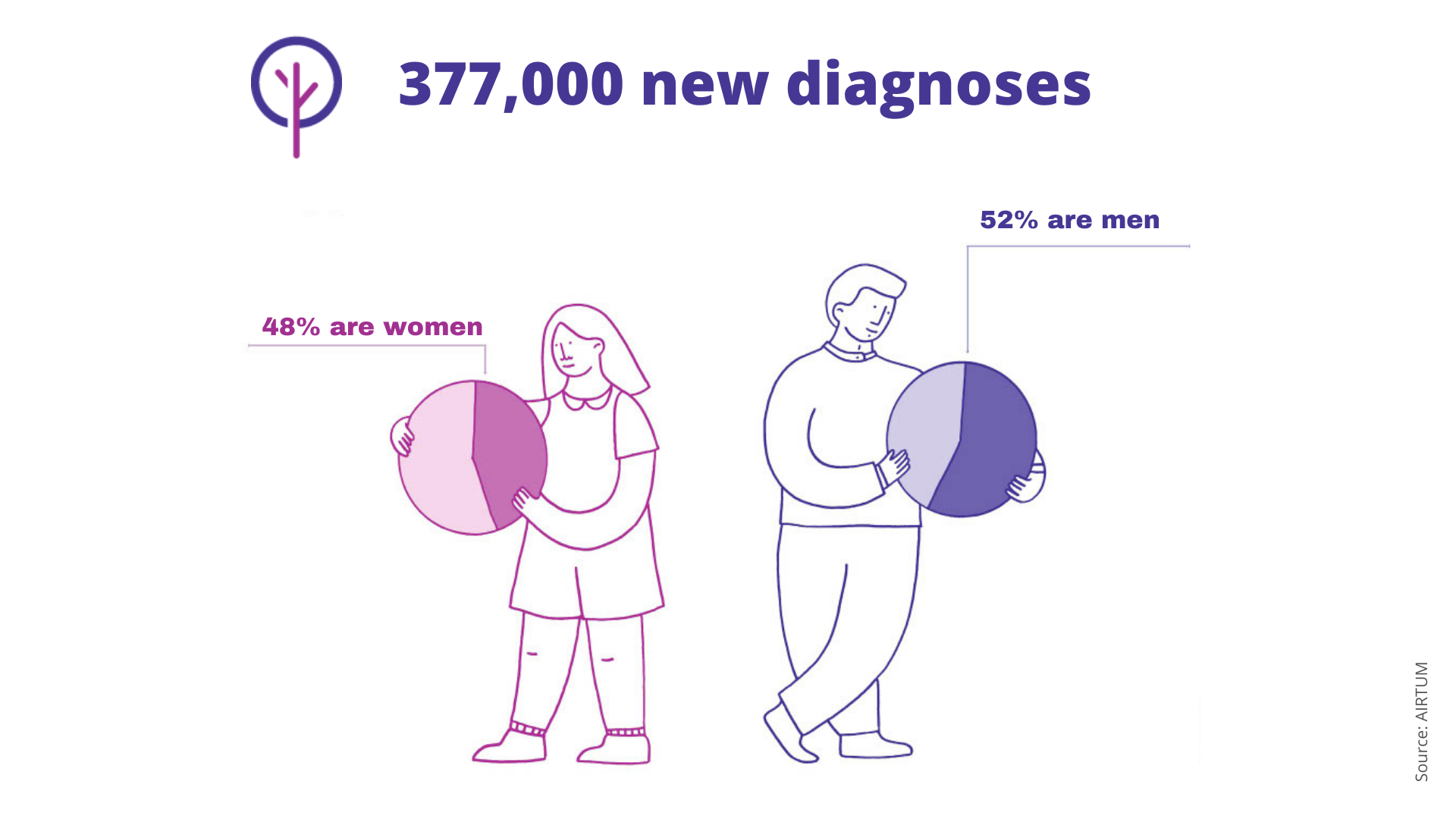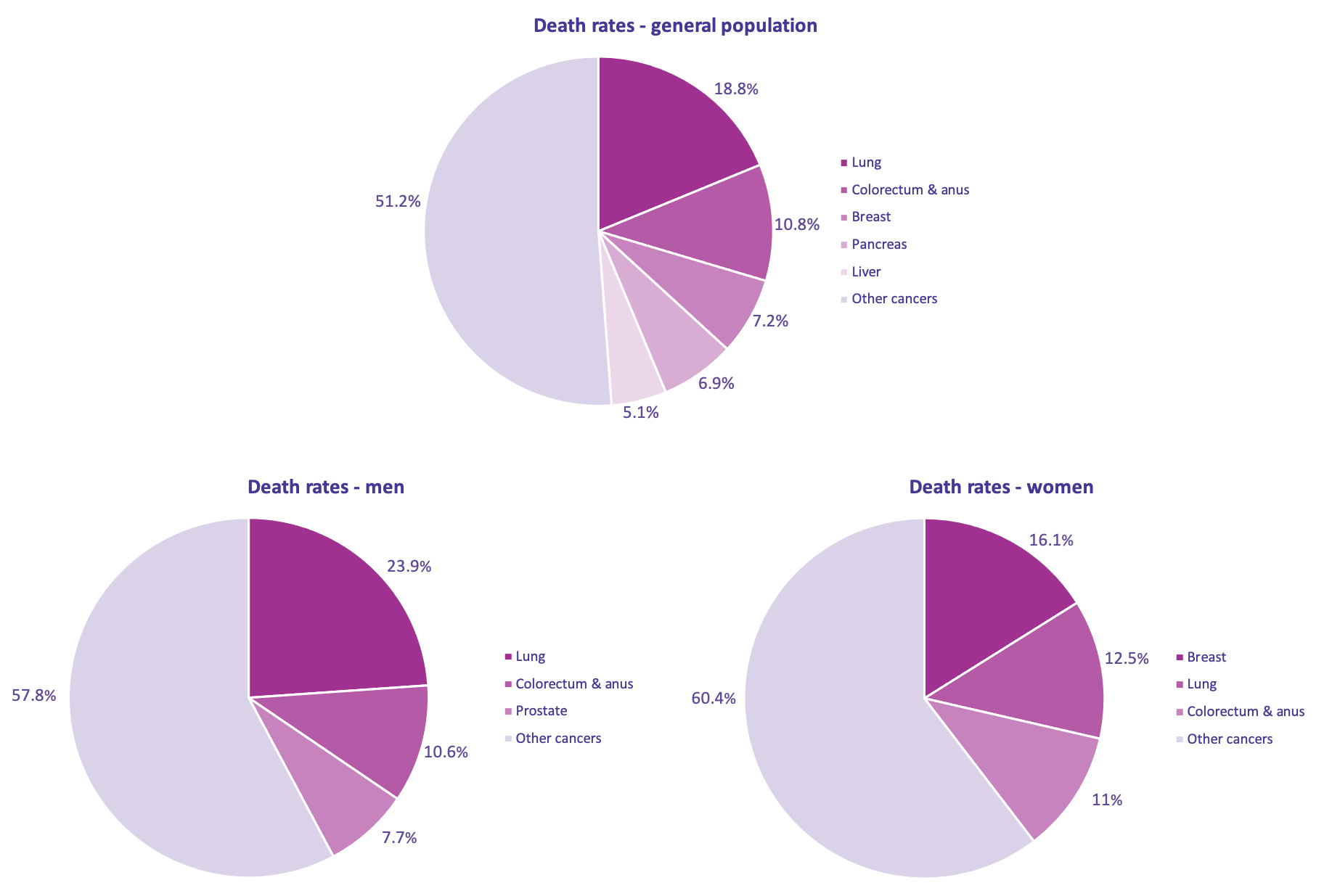Italian cancer numbers 2020
Just published the 10th AIOM-AIRTUM volume

October 8th, 2020
For the
tenth consecutive year AIRTUM and AIOM have published epidemiological data1
useful to know and manage the cancer disease.
In the volume Cancer Numbers 2020 we
find data on incidence, mortality, 5-year survival and prevalence2
in Italy.
Here are some of the questions these numbers answer.
What is the risk of getting cancer over a lifetime?
The risk measure is defined as the number of people who would need to be followed over a lifetime for one of them to be diagnosed with cancer. By convention, the time range from birth to 84 years (age close to the life expectancy of the Italian population) is taken into consideration.
The more frequent a type of cancer is, the fewer people will have to be followed to find one diagnosed with cancer. In general, it is estimated that 1 in 2 men and 1 in 3 women will get cancer in Italy during their lifetime.

Prostate
and breast are the most frequent
sites of cancer in males and females respectively: the probability of getting
sick is 1 in 8.
For lung cancer, which is more
common in the male sex, the probability is 1 in 10 men and 1 in 35 women; for
the colorectal cancer the
probability is 1 in 12 men and 1 in 19 women.
In the case of less frequent cancers, it will be necessary to follow a very large population to observe at least one case, for example in Kaposi's sarcoma, the probability of getting cancer is 1 in 509 in men and 1 in 1627 in women.
How many cancers will be diagnosed in 2020?
It is estimated that about 377,000 new cases of malignant tumor will be diagnosed in Italy, of which about 195,000 in men and about 182,000 in women. In Italy, 1,030 cancer diagnoses are made every day.

What are the 5 most frequently diagnosed cancers?


Incidence is influenced not
only by gender but also by age.
In young men, testicular cancer is
the most frequent cancer; in men over 50, prostate
cancer is the most frequent cancer.
In women, breast cancer represents
the most frequent cancer in all age groups.
How do cancer numbers change across Italy?
Geographic comparisons show significant North-South differences in the frequency of cancer in Italy. The average annual incidence rate is lower in Central Italy and in the South/Islands.
Differences also stand out for individual tumor sites. Liver tumors are more frequent in women in Southern Italy and in the Islands than in Northern or Central Italy. This result reflects some local genetic and environmental conditions, such as the prevalence of hepatitis B or C virus infections in Southern Italy.
With regards to melanoma, the incidence in Northern and Central Italy is twice as frequent as in the South in both men and women, highlighting the need for primary prevention campaigns for this cancer.
What cancers are rising and falling?
An overall increase in cancer incidence rates between 2008 and 2016 was documented in women (+1.3%/year) and in both sexes only in persons under 49 years of age (+0.7%/year in men, +1.6%/year in women).

What are the death rates due to cancer?
In 2017, cancer caused the death of 180,085 people in Italy, representing 27.7% of the deaths recorded
that year, 100,123 deaths among men and 79,962 among women.

t is estimated that in Italy
in 2020 cancer will be the cause of
death for 183,200 people, 101,900 men and 81,300 women.
Compared to 2015, we observe decreasing trends in death rates: -6% in men and -4% in women. Annual rates for some cancer types are also
decreasing.

What is the 5-year survival rate from cancer diagnosis?
Survival is the main
performance indicator in the oncology field, as it allows us to evaluate the
effectiveness of the healthcare system.
It is related to the stage at which the tumor is diagnosed (survival is better
the earlier the disease is diagnosed) and to the effectiveness of the therapies
undertaken.
In Italy, 5-year survival is 54% in men and 63% in women.
The better survival in women is related to the fact that the most frequent
cancer is breast cancer, which is
characterized by good prognosis, especially if diagnosed early.

The group of highest survival
cancers is represented by testicular
cancer and Hodgkin's lymphoma,
diseases that benefit from timely diagnosis and effective therapies.
As a result of screening campaigns3, colorectal and cervical
survivals are also improving.
Urothelial cancers4 show
medium to high levels of survival and progressive improvement over time.
A group of high-lethality diseases remain with survivals not exceeding 26%
(central nervous system, liver, lung, esophagus, mesothelioma, pancreas).
These are cancers that are already advanced at the time of diagnosis, whose
survival curve drops dramatically in the first year after diagnosis, and which
have not experienced significant improvement in the past three decades.
How many Italians are living with a cancer diagnosis?
In 2020, it is estimated that Italians living with a cancer diagnosis will be more than 3.6 million, 1 in 17 Italians, of whom 1.9 million are women (6% of the female population) and 1.7 million are men (5.6% of the male population).

Of these, nearly 2.4 million have been diagnosed for more than 5 years and about one-third for more than 10 years.
How many people can be considered cured after a cancer diagnosis?
It is estimated that 27% of those living in Italy after a
cancer diagnosis, almost 1 million
people, have returned to have the same outlook on life as the general
population: in clinical terms they are considered cured.
More than half of women diagnosed
with cancer are cured or expected to be cured
(52%), in men the percentage is lower
(39%) due to the higher frequency of cancers with a more severe prognosis.

The cure rate exceeds 75% in
men for prostate cancer and in both
sexes for thyroid cancer and melanomas.
For some types of cancer, such as breast
cancer, the risk of recurrence is maintained for over 20 years, but only 1/3 of
women will die from this cancer.
Even for patients with cancers of the bladder,
kidney, non-Hodgkin's lymphoma, myeloma,
and leukemia, the risk remains for
more than 15 years.
Source: I numeri del cancro in Italia 2020
1 Epidemiology is the biomedical discipline that studies the distribution and frequency of diseases and health relevant events in the population.
2 This refers to the number of people living after a cancer diagnosis.
3 A cancer screening test is a procedure to detect cancer at an early stage. In Italy, there are currently three screening programs, focusing on breast, cervical and colorectal cancer.
4 Tumors of the pelvis, kidney, ureter, bladder, and urethra.
